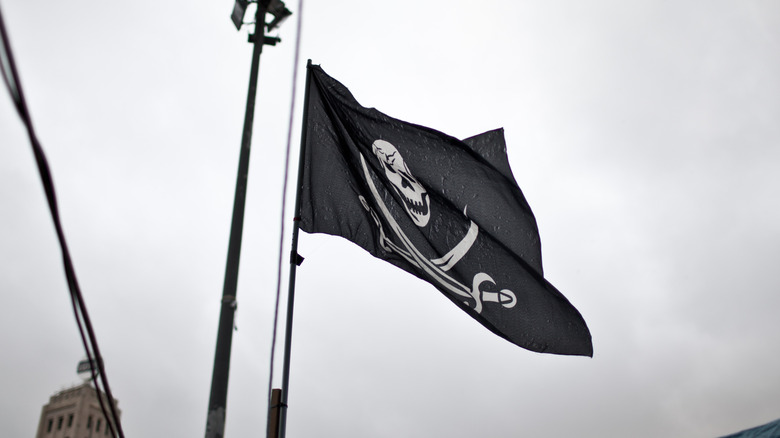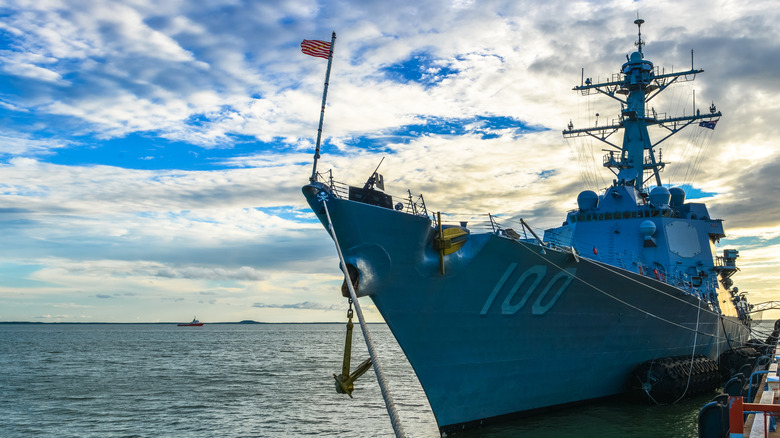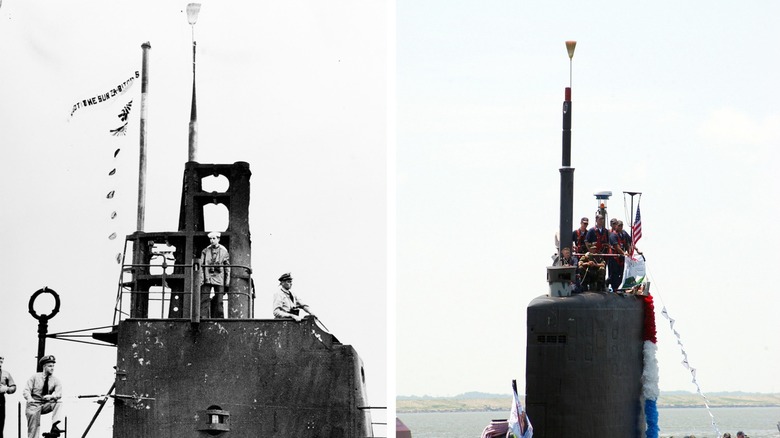Why Do Some Submarines Fly A Pirate Flag?
In the earliest days of military submarines, there were those who didn't agree with their tactics and considered them unbecoming. The First Sea Lord of the British Royal Navy, Adm. Arthur Wilson, specifically was vehemently against the use of submarines and made it clear that if hostile submarine crews were ever caught, they would be hanged liked pirates. Apparently Wilson's words resonated with the crew of British submarine HMS E9. When they returned to port after sinking a German cruiser in World War I, they flew the skull and crossbones to signify a successful mission. This was the first time a submarine flew the Jolly Roger flag, but it wouldn't be the last.
It started out with only British subs practicing the tradition but by World War II, other nations including Poland did the same thing. For a while submarines would display multiple flags, each one signifying a different vessel they successfully sunk. When it became too many flags for the sail, some crews were given a single flag to sew different symbols onto. Those symbols would represent the type of vessel they sunk, and they only received the flag after their first successful mission.
Now the world's oceans are flooded with ballistic and attack submarines with the U.S. brazenly displaying their practice of the tradition. The USS Jimmy Carter, the most advanced Seawolf-class and one of the deadliest submarines in the U.S. Navy, is commonly seen returning to port flying a pirate flag.
One other warship flies a pirate flag
Flying the skull and crossbones isn't reserved strictly for submarines these days. The USS Kidd, an Arleigh-Burke-class guided missile destroyer, commonly flies the Jolly Roger from its mast and unlike the USS Jimmy Carter, the crew doesn't wait until it returns from a successful patrol to do so. Naturally, the Navy doesn't think too highly of lawlessness, but tradition is a powerful force in the U.S. armed forces, so it allows the crew to fly the flag. The ship's namesake, Rear Adm. Isaac C. Kidd, shared his surname with a pirate captain from the 1700s and his fellow classmates at the Naval Academy gave him the nickname "Cap." Cap lost his life on the USS Arizona in the attack on Pearl Harbor.
As a way to commemorate him, the Navy named a Fletcher-class destroyer after him in 1943. The crew of this destroyer took the commemoration one step further and got permission from both Kidd's widow and the Navy to fly the skull and crossbones. Moreover, whenever the crew rescued downed pilots and returned them to their carrier, they asked for ice cream in return as a "ransom demand". They ended up being known as the Pirates of the Pacific. The pirate theme has followed the Kidd name around ever since.
The Arliegh-Burke destroyer takes the theme a little further by having the Jolly Roger emblem painted on the rear of its five-inch guns and the inside of the ship's doors.
It's not just flags they fly
Traditions have a tendency to evolve, especially when they're observed by new people. There's an unverified story from the 1600s describing a naval battle between the Dutch and English that the Dutch won, and when they returned home, the admiral in command of the fleet flew a broom on the mast of his vessel. It was a symbol that he swept the seas clean of his enemies. Hundreds of years later and the crew of the USS Wahoo (SS-238), one of the most celebrated submarines of WWII, became the first submarine to adopt the broom stick display as a tradition.
In 1943, the Wahoo's new commander made impressive and decisive choices that made the sub's third patrol a successful one. The Gato-class sub had already taken on a Japanese destroyer and two Japanese freighters without sustaining any damage itself. Commander, Dudley Walker "Mush" Morton, eventually spotted an oil tanker and a troop transport and made quick work of them, disabling them with two torpedoes.
When the Wahoo returned to Pearl Harbor after its patrol, onlookers saw a broom strapped to the periscope. U.S. Navy subs adopted this to mean that they sunk every enemy ship they engaged with. Displaying a broom didn't stay strictly with U.S. subs. Over time it expanded to the rest of the navy and it eventually signified non-combat accomplishments. Many ships will hang a broom from their mast whenever they successfully complete sea trials.


